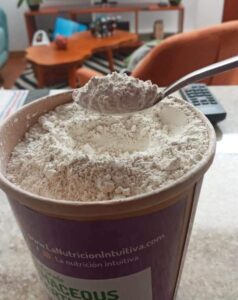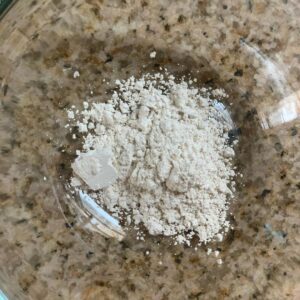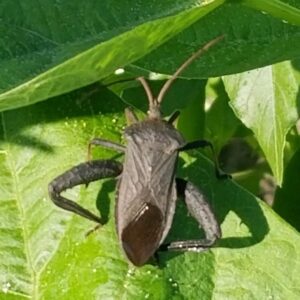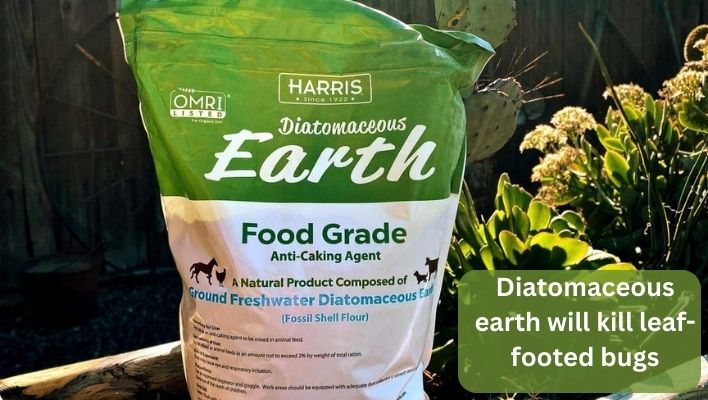Leaf-footed bugs are a common pest that can wreak havoc on crops and gardens. These insects have long, slender legs resembling leaves and can cause damage by piercing plants with needle-like mouths to feed on sap.
If you’re dealing with these pests, you may wonder, Will diatomaceous earth kill leaf-footed bugs? If left unchecked, leaf-footed bugs can cause stunted growth, fruit deformities, and even plant death.
Thankfully, there are natural pest control options available, and one of them is diatomaceous earth. Diatomaceous earth is a natural pest control option that many people have used to combat various pests, including leaf-footed bugs.
This white, powdery substance is made from the fossilized remains of tiny aquatic organisms called diatoms. It’s been used as an insecticide for decades and has gained popularity among gardeners and farmers looking for a safer alternative to chemical pesticides.
In this article, we’ll explore whether diatomaceous earth can effectively kill leaf-footed bugs and how to use it safely and effectively.
- Natural Product - Composed of 2lbs of 100% ground freshwater diatomaceous earth with absolutely no additives or fillers.ground freshwater diatomaceous earth with absolutely no additives or fillers.
- OMRI Listed - Listed with the Organic Minerals Research Institute, a non-profit organization that reviews products against organic standards.
- Powder Duster Included - Powder duster in the bag for easy and efficient application of diatomaceous earth on animal feed
How does diatomaceous earth work?
Diatomaceous earth works by physically damaging the exoskeleton of insects. This powdery substance comprises tiny fossilized diatoms with sharp edges that can cut through the waxy outer layer of an insect’s exoskeleton.
When an insect comes into contact with diatomaceous earth, the powder sticks to its body and begins to absorb the oils and fats from its exoskeleton. This causes the insect to dehydrate and eventually die.

One of the main benefits of using diatomaceous earth over chemical insecticides is that it is a natural and non-toxic substance. Chemical insecticides can harm beneficial insects and negatively affect the environment, whereas diatomaceous earth is safe for humans, pets, and other animals.
Additionally, diatomaceous earth leaves no harmful residues that could contaminate the soil or water. It can also be used on various plants and crops, making it a versatile option for gardeners and farmers.
Diatomaceous earth Can kill leaf-footed bugs
Diatomaceous earth can be an effective way to kill leaf-footed bugs. Studies have shown that diatomaceous earth can cause high mortality rates in leaf-footed bugs and other pests, making it a popular natural insecticide for gardeners and farmers.
One study by the University of California Cooperative Extension found that diatomaceous earth effectively controlled various pests, including leaf-footed bugs, in tomato plants. The researchers found that applying diatomaceous earth around the base of the plants reduced the number of pests and increased the yield of the tomatoes.
Another study published in the Journal of Economic Entomology found that diatomaceous earth effectively controlled various pests in almond orchards, including leaf-footed bugs. The researchers found that applying diatomaceous earth reduced the number of pests and damage to the almond crops.
While the effectiveness of diatomaceous earth can vary depending on the insect species and the application method, it has shown to be a promising natural alternative to chemical insecticides for controlling leaf-footed bugs and other pests.
- Natural Product - Composed of 2lbs of 100% ground freshwater diatomaceous earth with absolutely no additives or fillers.ground freshwater diatomaceous earth with absolutely no additives or fillers.
- OMRI Listed - Listed with the Organic Minerals Research Institute, a non-profit organization that reviews products against organic standards.
- Powder Duster Included - Powder duster in the bag for easy and efficient application of diatomaceous earth on animal feed
How to use diatomaceous earth to kill leaf-footed bugs?
Following proper application methods and safety precautions is important when using diatomaceous earth to control leaf-footed bugs. Here are some step-by-step instructions for using diatomaceous earth to control leaf-footed bugs:
- Choose the right type of diatomaceous earth: Make sure you purchase food-grade diatomaceous earth, which is safe for use around humans, pets, and other animals. Do not use pool-grade diatomaceous earth, as it contains additional chemicals that can be harmful.
- Start by wearing gloves and a dust mask to protect yourself from inhaling the fine dust of diatomaceous earth.
- Identify the areas where leaf-footed bugs are present, paying close attention to the underside of leaves and stems where they like to hide.
- Lightly dust a thin layer of diatomaceous earth onto the affected areas, making sure to cover the leaves and stems thoroughly. Be careful not to apply too much, as this can reduce its effectiveness.
- Reapply the diatomaceous earth after rainfall or heavy watering, as these can wash away the powder.
- Monitor the area and continue to apply diatomaceous earth as needed until the leaf-footed bug population is under control.

Make Diatomaceous earth Spray
While it’s possible to mix diatomaceous earth with water to create a spray for controlling leaf-footed bugs, this method may not be as effective as applying the powder directly to the bugs and their hiding places. However, if you’d like to try using a spray, here’s how to do it:
Materials:
- Diatomaceous earth powder
- Water
- Spray bottle
Instructions:
- Mix one cup of diatomaceous earth powder with one gallon of water in a bucket. Stir well to ensure that the powder is evenly distributed.
- Transfer the mixture to a spray bottle.
- Spray the mixture onto the leaves and stems of affected plants, focusing on areas where you’ve seen leaf-footed bugs or their eggs.
- Reapply the spray every few days to ensure that new bugs are also affected.
- When using the spray, be sure to wear gloves, a mask, and eye protection to avoid inhaling the dust.
Note that using diatomaceous earth as a powder or dust is typically a more effective way to control leaf-footed bugs, as it allows the bugs to come into direct contact with the powder. When using diatomaceous earth as a powder, sprinkle it onto the leaves and stems of affected plants or in areas where you’ve seen bugs or their eggs. Reapply the powder as needed, especially after rain or watering.

It’s important to note that diatomaceous earth should be applied directly to the bugs in order to be effective. There may need to be more than simply spraying it on the leaves or surrounding area to control the pests.
In addition to proper application methods, taking safety precautions when using diatomaceous earth is important. As mentioned, wearing gloves and a dust mask is important to protect yourself from inhaling the fine dust. It’s also important to keep pets and children away from the area until the diatomaceous earth has settled and to avoid applying it on windy days.
Following proper application methods and safety precautions, diatomaceous earth can be a safe and effective way to control leaf-footed bugs in your garden or farm.
Are there any risks associated with using diatomaceous earth?
While diatomaceous earth is generally considered safe to use, there are still some risks and concerns to be aware of. One of the main risks associated with diatomaceous earth is inhalation. When handling and applying diatomaceous earth, wearing a dust mask and gloves is important to avoid inhaling the powder or getting it on your skin.
Another potential risk is that diatomaceous earth can harm beneficial insects such as bees, ladybugs, and other pollinators. To avoid harming these important insects, it’s best to apply diatomaceous earth in the evening when they are less active or to avoid applying it directly to flowers where pollinators are likely to visit.
It’s also important to note that while diatomaceous earth is a natural and non-toxic substance, it can still be harmful if ingested. Keep it out of reach of children and pets, and avoid using it in areas where they are likely to come into contact with it. To use diatomaceous earth safely and effectively, below are a few tips to follow.
- Natural Product - Composed of 2lbs of 100% ground freshwater diatomaceous earth with absolutely no additives or fillers.ground freshwater diatomaceous earth with absolutely no additives or fillers.
- OMRI Listed - Listed with the Organic Minerals Research Institute, a non-profit organization that reviews products against organic standards.
- Powder Duster Included - Powder duster in the bag for easy and efficient application of diatomaceous earth on animal feed
Here are a few tips to keep in mind:
- Always use food-grade diatomaceous earth: This type of diatomaceous earth is safe for use around humans and animals, while pool-grade diatomaceous earth contains additional chemicals that can be harmful.
- Wear protective gear: Wear a dust mask and gloves when handling and applying diatomaceous earth to avoid inhalation and skin irritation.
- Apply properly: Apply diatomaceous earth in a light dusting, covering all sides of the plant. Reapply as needed and avoid applying on windy days.
- Use with caution around beneficial insects: Apply diatomaceous earth in the evening or avoid applying it directly to flowers where pollinators are likely to visit.
With proper precautions and responsible use, diatomaceous earth can be a safe and effective natural pest control option for controlling leaf-footed bugs and other insect pests.
Other methods for controlling leaf-footed bugs
While diatomaceous earth can be an effective natural pest control option for leaf-footed bugs, other methods are also available. Here are a few alternative options to consider:
- Handpicking: One option is to handpick the leaf-footed bugs off of your plants. While this can be time-consuming, it can be effective for smaller infestations. However, this method may not be practical for larger gardens or farms.
- Neem oil: Neem oil is a natural insecticide effective against leaf-footed bugs. It works by disrupting the bugs’ hormone systems and can also repel them from plants. However, it’s important to note that neem oil can also harm beneficial insects and may need to be reapplied frequently.
- Row covers: Row covers are lightweight fabrics that can cover plants and protect them from insects. They can be effective for preventing leaf-footed bugs from infesting plants in the first place, but they may need to be more practical for larger plants or gardens.
- Insecticidal soap: Insecticidal soap is a natural and non-toxic option effective against leaf-footed bugs. It works by disrupting the bugs’ cell membranes and can be used as a spray on plants. However, it may need to be reapplied frequently and may harm beneficial insects as well.
When considering these alternative methods, it’s important to weigh the pros and cons of each. Handpicking may be effective but time-consuming, while neem oil and insecticidal soap may harm beneficial insects.
Row covers may be effective for preventing infestations but may not be practical for larger gardens or plants. Ultimately, the best pest control option depends on your situation and preferences.
It’s important to note that whichever method you choose, it’s always a good idea to monitor your plants regularly for signs of leaf-footed bugs and other pests and to take action as soon as you notice an infestation. By being proactive and using the right pest control methods, you can protect your plants and enjoy a healthy and thriving garden.
Frequently asked questions
Can diatomaceous earth harm beneficial insects?
While diatomaceous earth is generally considered safe for humans and pets, it can harm beneficial insects such as bees and ladybugs if they come into direct contact with it. Therefore, it’s important to use it carefully and only where necessary. To avoid harming beneficial insects, apply diatomaceous earth only to affected areas of plants rather than the entire plant. Avoid applying it when beneficial insects are most active.
Is diatomaceous earth safe for humans and pets?
Diatomaceous earth is generally safe for humans and pets to be around, but it’s important to use it properly and avoid inhaling it. While it’s non-toxic, it can irritate the skin and eyes, so it’s important to wear gloves and protective eyewear when handling it.
Also, It’s important to use food-grade diatomaceous earth and to follow the recommended application instructions carefully.
Inhalation of diatomaceous earth dust can irritate the lungs, so it’s important to wear a mask when applying it. Additionally, it’s best to keep pets and children away from treated areas until the diatomaceous earth has settled.
Will diatomaceous earth work on other types of pests besides leaf-footed bugs?
Yes, diatomaceous earth can be effective against many types of pests, including ants, cockroaches, and fleas. However, it may only be effective against some types of pests and may need to be combined with other pest control methods for the best results. It works by dehydrating the exoskeleton of insects and can be effective against any insect with an exoskeleton.
How long does diatomaceous earth remain effective?
Diatomaceous earth remains effective as long as it remains dry and undisturbed. However, it may need to be reapplied after rain or watering or if it becomes too caked or clumped to be effective. However, it’s important to reapply it after rainfall or heavy watering, as moisture can reduce its effectiveness.
Why are leaf-footed bugs considered pests?
Leaf-footed bugs are considered pests because they can cause significant damage to plants, including fruits and vegetables. They feed on plant juices and can cause the fruits or vegetables to become disfigured or drop prematurely, reducing yields and making them a major concern for gardeners and farmers.
Additionally, they can transmit plant diseases and attract other pests to the area. Controlling leaf-footed bugs is important for protecting plants and ensuring a healthy harvest.
Conclusion
In conclusion, leaf-footed bugs can cause significant damage to plants, and diatomaceous earth is a natural pest control option that can help control their population. Diatomaceous earth works by physically damaging the exoskeleton of insects, making it an effective alternative to chemical insecticides.
When using diatomaceous earth, following the proper application methods and safety precautions is important. While diatomaceous earth may not be the only solution for controlling leaf-footed bugs, it is a safe and effective method that can be used alone or in combination with other pest control methods.
It is also versatile and can control other types of pests. Using diatomaceous earth, gardeners and farmers can protect their plants and ensure a healthy harvest without relying on harmful chemicals.
We encourage readers to try diatomaceous earth and see the benefits for themselves. Proper use and application can be an effective solution for controlling leaf-footed bugs and other pests.

